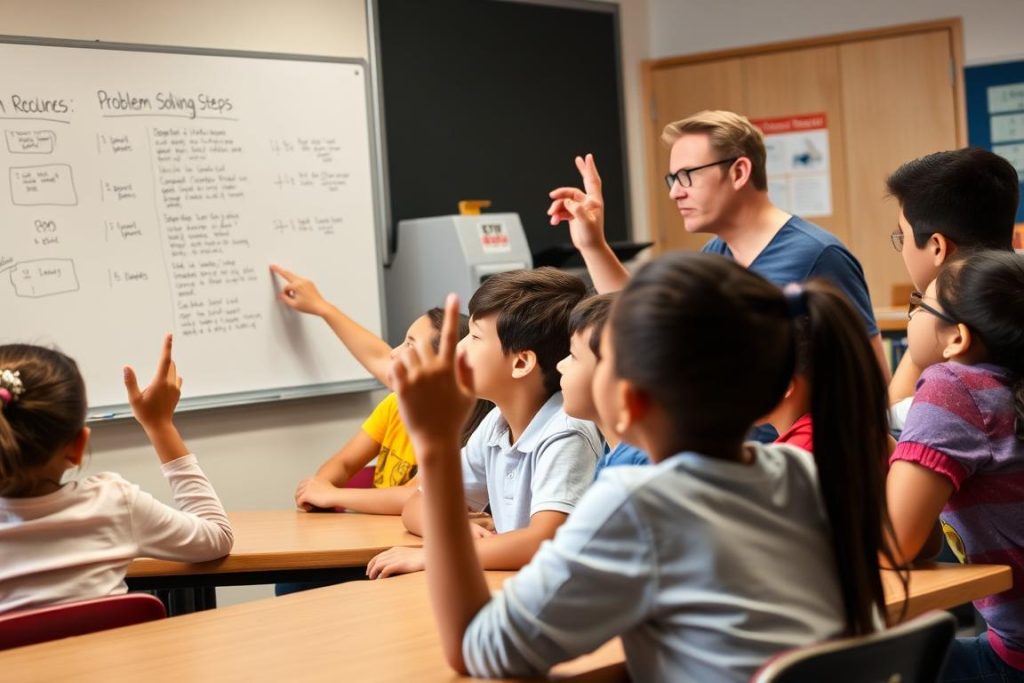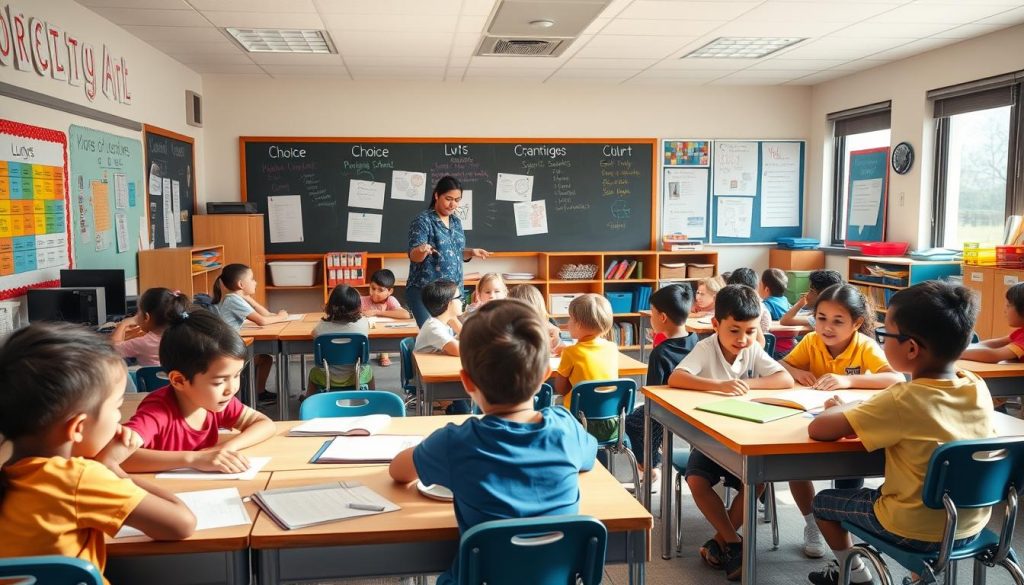As K12 teachers, developing effective teacher skills for managing behavior isn’t just about maintaining order—it’s about preparing students for success beyond our classrooms. The Love and Logic approach provides practical tools that enhance your teacher skills while reducing stress and preventing burnout. Let’s explore how these principles can transform your teaching experience and your students’ learning journey.
Understanding the Love and Logic Core Principles: Shared Control
The first fundamental principle in the Love and Logic approach centers on sharing control with students. This might seem counterintuitive—after all, aren’t teachers supposed to maintain control of their classrooms? The key distinction is between controlling students and controlling the environment where learning happens.
When we attempt to control students directly, we often create power struggles that damage relationships and actually increase misbehavior. Instead, effective teacher skills include offering small choices within limits you establish. This approach satisfies students’ developmental need for autonomy while keeping you firmly in the driver’s seat.
How to Implement Shared Control
Sharing control doesn’t mean surrendering your authority. Rather, it means strategically offering choices that are acceptable to you. For example, instead of demanding, “Complete this worksheet now,” you might say, “Would you prefer to complete this worksheet at your desk or at the reading table?” Both options accomplish your goal, but the student gains a sense of ownership in the process.
- Offer two acceptable choices rather than open-ended options
- Keep the tone respectful and genuine, not manipulative
- Use choices preventively before problems occur
- Ensure all options lead to your desired outcome
- Start small and build more choice opportunities as students demonstrate responsibility
When students feel they have some control over their environment, they’re less likely to seek control through disruptive behavior. This principle helps teachers develop essential teacher skills for creating a cooperative classroom climate where students feel respected and valued.
Enhance Your Teacher Skills with Love and Logic Training
Discover how to implement the shared control principle effectively in your specific grade level and subject area. Our specialized training helps you master these techniques while earning professional development credits.
Empathy: The Heart of Love and Logic Core Principles
The second principle—and perhaps the most transformative—is leading with empathy before consequences. Traditional discipline often jumps straight to punishment, missing a crucial opportunity to build connection and teach emotional intelligence. In contrast, Love and Logic emphasizes expressing genuine empathy first, then allowing appropriate consequences to do the teaching.

This approach requires developing teacher skills in emotional regulation and authentic communication. When a student makes a poor choice, your first response should communicate care for them as a person, even as you allow them to experience the natural or logical consequences of their actions.
The Empathy Formula
Love and Logic provides a simple formula that helps teachers respond effectively to misbehavior:
Express empathy → Allow consequences → Maintain the relationship
For example, when a student fails to complete homework, instead of lecturing or expressing disappointment, you might say: “Oh, that’s so sad you didn’t get your homework done. I bet that feels disappointing. The good news is you’ll have another chance to show what you know during lunch today while you complete it.”
This response demonstrates key teacher skills: emotional regulation, clear communication, and the ability to separate the student’s worth from their behavior. Students learn that mistakes are opportunities for growth rather than reasons for rejection.
Why Empathy Works
When we lead with empathy, we:
- Preserve the relationship during disciplinary moments
- Model emotional intelligence for students
- Reduce defensiveness so learning can occur
- Create safety for students to own their mistakes
- Avoid power struggles that escalate situations
Without empathy, consequences often:
- Generate resentment rather than reflection
- Teach students to avoid getting caught
- Damage the teacher-student relationship
- Model that power, not respect, is the goal
- Create a classroom climate of fear
Research consistently shows that students learn best in environments where they feel emotionally safe. By developing teacher skills in empathetic response, you create precisely this type of environment—one where mistakes are viewed as learning opportunities rather than character flaws.
Developing Problem-Solving Skills: A Core Love and Logic Core Principles
The third principle focuses on helping students develop problem-solving skills rather than rescuing them from challenges. Many well-intentioned teachers jump in too quickly to solve students’ problems, inadvertently teaching dependence rather than resilience. Love and Logic encourages teachers to guide students through solving their own problems.
This approach requires specific teacher skills: asking thoughtful questions, providing appropriate guidance without taking over, and allowing students to experience the natural consequences of their choices. The goal is to gradually transfer responsibility for problem-solving from teacher to student.
The Problem-Solving Process
- Express empathy first: “That sounds like a challenging situation.”
- Ask permission to share ideas: “Would you like to hear what other students have tried?”
- Offer choices/suggestions: “Some kids find it helpful to… Others have tried…”
- Let the student decide: “What do you think might work for you?”
- Allow natural consequences: “Good luck! Let me know how it works out.”
This process helps students develop critical thinking skills while sending the message that you believe in their capabilities. It’s a significant shift from traditional approaches where teachers typically tell students exactly what to do or solve problems for them.

Real Classroom Application
Consider this scenario: Two students are arguing over classroom materials. A traditional response might be to step in, determine who’s “right,” and impose a solution. Using Love and Logic, you might instead say:
“Wow, it looks like you two have a problem to solve. I’m confident you can figure this out respectfully. What are some ways you might solve this problem? Would you like some suggestions, or would you prefer to work it out yourselves first?”
This response demonstrates advanced teacher skills: conflict mediation, promoting student agency, and building problem-solving capacity. Over time, students internalize this process and become more independent in resolving conflicts.
Master Problem-Solving Facilitation
Learn specific techniques for guiding students through the problem-solving process with our comprehensive Love and Logic training program.
Setting Limits with Enforceable Statements: Essential Love and Logic Core Principles
The fourth principle focuses on how teachers communicate expectations and boundaries. Traditional discipline often relies on commands, threats, or repeated warnings that teachers cannot consistently enforce. Love and Logic introduces a powerful alternative: enforceable statements.
Enforceable statements focus on what you will do rather than what you want students to do. This shift represents a crucial teacher skill that prevents power struggles while maintaining clear boundaries.
Unenforceable Statements
- “Stop talking and pay attention!”
- “You need to respect each other.”
- “Don’t run in the hallway!”
- “You have to complete this assignment.”
- “Be quiet while I’m teaching.”
Enforceable Statements
- “I teach when students are listening.”
- “I allow students to stay in groups when they speak respectfully.”
- “I keep students safe by having them walk in the hallway.”
- “I give credit for completed assignments.”
- “I’ll continue when the room is quiet.”
The key difference is that enforceable statements describe what you will do or allow, not what students must do. This approach respects student autonomy while clearly communicating expectations. It’s a subtle but powerful shift in teacher language that dramatically reduces power struggles.

Creating Your Own Enforceable Statements
Developing this teacher skill requires practice. Here’s a simple formula for creating enforceable statements:
“I (provide/allow/teach/give) when (specific condition is met).”
For example, instead of saying, “Turn in your homework on time,” you might say, “I accept homework until 3:00 pm for full credit.” This statement clearly communicates your expectation while acknowledging that the student ultimately controls whether they meet it.
Enforceable statements work because they:
- Preserve student dignity and autonomy
- Prevent power struggles by avoiding direct commands
- Clearly communicate expectations and consequences
- Model respectful communication
- Place responsibility for choices with the student
This approach requires developing teacher skills in thoughtful communication and emotional regulation. Rather than reacting in the moment, teachers learn to respond with carefully crafted statements that maintain boundaries without creating confrontation.
Delayed Consequences: The Fifth Love and Logic Core Principles
The fifth principle introduces a powerful concept that contradicts conventional wisdom: delaying consequences can actually increase their effectiveness. Traditional approaches often emphasize immediate consequences, but Love and Logic suggests that thoughtfully delayed consequences often work better—especially for more significant behavioral issues.
This approach requires developing teacher skills in patience, strategic thinking, and emotional regulation. Instead of reacting immediately to misbehavior, teachers learn to respond with empathy in the moment while thoughtfully planning appropriate consequences for later.
The Delayed Consequence Formula
- Respond with empathy: “I notice there’s a problem here. This is sad.”
- Buy yourself time: “I need to think about this and decide what to do.”
- Delay the consequence: “We’ll talk about this later when we’re both calm.”
- Implement thoughtfully: Choose a logical consequence that teaches rather than punishes.
This approach offers several advantages over immediate consequences. It gives both teacher and student time to calm down, allows for more thoughtful selection of logical consequences, and creates anticipation that often increases the impact of the eventual consequence.
When to Use Delayed Consequences
Delayed consequences work best for:
Appropriate Situations:
- Repeated behavioral issues
- Situations requiring investigation
- Complex problems needing thoughtful response
- When emotions are running high
- When immediate consequences aren’t available
Less Appropriate Situations:
- Safety emergencies requiring immediate action
- Very young students who need immediate feedback
- When the natural consequence is already occurring
- When a teaching moment would be lost
Mastering this principle enhances teacher skills in thoughtful discipline and emotional regulation. Rather than reacting from frustration, teachers learn to respond strategically in ways that preserve relationships while still addressing behavioral concerns.
“The best consequences are not delivered in anger but in sadness, with empathy.”
This approach represents a significant shift from traditional discipline methods that often rely on immediate punishment delivered in anger or frustration. By developing the teacher skill of delayed response, educators create more thoughtful, effective interventions.
Transform Your Classroom Management Approach
Learn how to implement all five Love and Logic Core Principles with our comprehensive training program, designed specifically for K12 teachers.
Implementing Love and Logic Core Principles in Your Classroom
Understanding the principles is just the beginning—successful implementation requires practice, consistency, and ongoing refinement of your teacher skills. Here’s a practical roadmap for bringing Love and Logic to life in your classroom:
Start Small and Build Gradually
Rather than trying to implement all five principles simultaneously, focus on mastering one principle at a time. Many teachers find success beginning with enforceable statements or offering small choices, as these techniques can be implemented immediately with visible results.
- Choose one principle to focus on for 2-3 weeks
- Practice the language and techniques consistently
- Notice and celebrate small successes
- Add additional principles as you gain confidence
Create a Classroom Philosophy
Develop a simple, clear classroom philosophy based on Love and Logic principles. This might include statements like:
“In our classroom, we solve problems with respect, make choices within limits, and learn from mistakes. I will treat you with dignity, and I expect the same in return.”
Share this philosophy with students and parents at the beginning of the year, and refer back to it consistently. This creates a foundation for your implementation and helps everyone understand your approach.

Anticipate and Plan for Challenges
Implementing a new approach inevitably comes with challenges. Common obstacles include:
Teacher Challenges:
- Reverting to old habits under stress
- Inconsistent application of principles
- Difficulty finding the right words in the moment
- Concerns about administrative or parent support
Student Responses:
- Testing boundaries during transition
- Confusion about new expectations
- Attempts to manipulate the system
- Varying responses based on previous experiences
Anticipating these challenges allows you to develop specific teacher skills and strategies to address them. For example, you might create a personal “script book” with enforceable statements for common situations or find a colleague who can provide support and accountability.
Love and Logic Core Principles in Action: Teacher Success Stories
The true test of any educational approach is its effectiveness in real classrooms. Here are examples of how teachers have successfully implemented Love and Logic principles to transform challenging situations:
Elementary School: The Homework Battle
Challenge: A third-grade teacher was frustrated with constant battles over incomplete homework and the time spent nagging students and contacting parents.
Love and Logic Solution: Instead of nagging or punishing, the teacher implemented a simple system: students who completed homework participated in a special 15-minute activity at the beginning of each day. Those who didn’t used that time to complete their missing work.
Result: Homework completion rates increased from 65% to 90% within three weeks. The teacher reported spending significantly less time on homework issues and more time on instruction. Students developed greater responsibility and the classroom atmosphere improved dramatically.
Teacher Skills Developed: Setting clear expectations, implementing logical consequences, and shifting responsibility to students.
Middle School: The Chronic Disruptor
Challenge: A seventh-grade science teacher struggled with a student who constantly disrupted class with inappropriate comments and attention-seeking behavior.
Love and Logic Solution: Rather than engaging in power struggles, the teacher began responding with empathy and delayed consequences: “That’s sad that you’re having trouble participating appropriately. I’ll need to think about this and we’ll talk later.” Later, privately, the teacher offered choices about how the student could make amends and earn back class participation privileges.
Result: After initial testing of boundaries, the student’s disruptive behavior decreased significantly. The teacher maintained a positive relationship while still addressing the behavior, and other students noticed the respectful approach.
Teacher Skills Developed: Emotional regulation, private problem-solving, and maintaining relationships during discipline.
High School: The Apathetic Class
Challenge: A high school English teacher faced a class of seemingly unmotivated students who rarely participated and showed little investment in their learning.
Love and Logic Solution: The teacher implemented increased choice within the curriculum, allowing students to select from assignment options, choose discussion topics, and have input on assessment methods—all within appropriate academic boundaries.
Result: Student engagement increased dramatically as they experienced ownership in their learning. Assignment completion improved, and the quality of work exceeded the teacher’s expectations. Students reported greater enjoyment of the class and developed more self-directed learning habits.
Teacher Skills Developed: Designing choice-based learning experiences, balancing structure with autonomy, and building student investment.
These examples illustrate how Love and Logic principles can be adapted across grade levels and for various classroom challenges. In each case, teachers developed specific teacher skills that enhanced their effectiveness while reducing stress and improving student outcomes.
Join Teachers Who’ve Transformed Their Classrooms
Learn how to implement these same strategies in your unique classroom situation with our comprehensive Love and Logic training.
The Research Behind Love and Logic Core Principles
While Love and Logic’s practical approach appeals to many educators, it’s also important to understand the research foundation supporting these principles. The approach aligns with several evidence-based educational and psychological theories:
Alignment with Educational Research
- Self-Determination Theory: Research by Ryan and Deci shows that autonomy, competence, and relatedness are essential for intrinsic motivation—all elements supported by Love and Logic’s emphasis on choice, problem-solving, and relationship.
- Social-Emotional Learning: Studies consistently show that SEL programs improve academic performance while reducing behavioral problems. Love and Logic’s emphasis on empathy and problem-solving directly supports SEL development.
- Restorative Practices: Research on restorative approaches to discipline shows they reduce recidivism and improve school climate—aligning with Love and Logic’s focus on repairing harm rather than punitive measures.
- Growth Mindset: Carol Dweck’s research on mindset connects directly to Love and Logic’s approach to mistakes as learning opportunities rather than character flaws.
These research connections highlight how Love and Logic principles support the development of essential teacher skills that align with contemporary educational best practices. The approach isn’t simply a collection of techniques but a coherent philosophy grounded in our understanding of how students learn and develop.
Outcomes and Effectiveness
Schools implementing Love and Logic consistently report several positive outcomes:
For Students:
- Increased responsibility and problem-solving skills
- Improved behavior and reduced disciplinary incidents
- Greater engagement and academic performance
- Enhanced emotional regulation and social skills
- Stronger sense of belonging and connection
For Teachers:
- Reduced stress and emotional exhaustion
- More positive teacher-student relationships
- Increased instructional time (less spent on discipline)
- Greater job satisfaction and retention
- Enhanced teacher skills and professional confidence
These outcomes highlight why developing teacher skills in Love and Logic principles represents a worthwhile investment for educators seeking both professional growth and classroom improvement.
Frequently Asked Questions About Love and Logic Core Principles
How long does it take to see results with Love and Logic?
Many teachers report seeing initial improvements within 2-3 weeks of consistent implementation, particularly with strategies like enforceable statements and offering choices. However, deeper transformation typically takes 3-6 months as both teacher skills and student responses develop. The key is consistency—implementing the principles regularly even when initial results vary.
Does Love and Logic work for students with special needs?
Yes, with appropriate adaptations. The principles of empathy, choice within limits, and logical consequences work well for many students with special needs, though implementation may need modification based on specific challenges. For students with significant emotional or behavioral disorders, consulting with specialists while implementing Love and Logic can create a comprehensive approach that supports their unique needs.
How do I handle parents who question this approach?
Transparent communication is key. Share your classroom philosophy early, explaining how Love and Logic principles support student development of responsibility and problem-solving skills. Highlight the research basis and focus on outcomes—improved behavior, stronger relationships, and enhanced learning. Many schools find that offering parent workshops on Love and Logic creates consistency between home and school approaches.
What if my administration uses a different discipline approach?
Many Love and Logic principles can complement other approaches. Focus on elements that align with your school’s existing framework, such as empathy or logical consequences. Discuss with administrators how these teacher skills enhance your effectiveness while supporting school-wide goals. Many teachers successfully implement Love and Logic within their classrooms while still adhering to broader school policies.
How do I maintain consistency with Love and Logic when I’m stressed or overwhelmed?
This is a common challenge that requires developing specific teacher skills in self-regulation. Create “emergency response” scripts for challenging moments, practice self-care routines that support emotional regulation, and find a colleague who can provide accountability and support. Remember that perfection isn’t required—even implementing these principles part of the time creates positive change.
Transforming Your Classroom with Love and Logic Core Principles
Implementing the Love and Logic Core Principles represents more than just adopting new classroom management techniques—it’s about transforming your approach to teaching and your relationship with students. By developing teacher skills in sharing control, expressing empathy, guiding problem-solving, using enforceable statements, and implementing thoughtful consequences, you create a classroom environment where students thrive academically, socially, and emotionally.
The journey of implementing these principles takes time and practice, but the rewards are substantial: reduced stress, fewer power struggles, increased instructional time, and students who gradually develop the responsibility and problem-solving skills they’ll need throughout life. Perhaps most importantly, you’ll preserve the joy of teaching that brought you to this profession in the first place.

Whether you’re facing specific classroom challenges or simply seeking to enhance your teaching approach, the Love and Logic Core Principles offer practical, proven strategies that align with contemporary educational research while addressing the real-world demands of today’s classrooms.
Ready to Transform Your Teaching Experience?
Take the next step in developing your teacher skills with comprehensive Love and Logic training. Gain practical strategies, earn professional development credits, and join a community of educators committed to positive classroom transformation.




